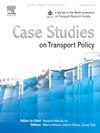Presenting the behavioral model of citizens in selection of trip vehicle with emphasis on how to go to work
IF 2.4
Q3 TRANSPORTATION
引用次数: 0
Abstract
Understanding the factors that influence individual vehicle choice behavior will reveal changes in preferences and attitudes. These changes can provide insights into travel patterns, improve transportation planning, prepare for future infrastructure needs and services, and inform better design and implementation of sustainable and inclusive transportation. The purpose of this research is to provide a behavioral model of citizens in choosing a travel vehicle with an emphasis on how to go to work in Shiraz, Iran. The statistical method used in this research is the logit mathematical model. SPSS software was used to analyze the research results. Different hypothetical scenarios were investigated according to the final vehicle selection model and the possibility of choosing different travel vehicles in each of the hypothetical scenarios. The results of the comparison of logit models for all travel destinations showed that the behavior of Shiraz citizens in choosing a means of transportation is not nested. For this reason, the final model was chosen for business trips. The results obtained from the hypothetical scenarios of the business travel selection tool in Shiraz showed that if none of the demand management policies and the creation of high-speed buses are applied, the share of private cars is 38 %, the share of buses and subways is 32 %, the share of taxi travel is 30 %, and the share of walking will be 33 %. Also, social conditions and demographic characteristics do not have a significant effect on the choice of vehicle and travel behavior of citizens to the workplace.
提出了市民出行车辆选择的行为模型,并以上下班方式为重点
了解影响个人车辆选择行为的因素将揭示偏好和态度的变化。这些变化可以洞察出行模式,改善交通规划,为未来的基础设施需求和服务做好准备,并为更好地设计和实施可持续和包容性交通提供信息。本研究的目的是提供一个行为模型的公民在选择旅行工具,重点是如何去上班在设拉子,伊朗。本研究采用的统计方法是logit数学模型。采用SPSS软件对研究结果进行分析。根据最终的车辆选择模型,研究了不同的假设情景,以及在每个假设情景中选择不同出行车辆的可能性。各旅游目的地的logit模型比较结果表明,设拉子居民在交通工具选择上的行为是不嵌套的。出于这个原因,最后的模型被选择用于商务旅行。从设拉子的商务旅行选择工具的假设情景中获得的结果表明,如果不应用任何需求管理政策和创建高速公交车,私家车的份额为38%,公共汽车和地铁的份额为32%,出租车的份额为30%,步行的份额将为33%。此外,社会条件和人口特征对公民的交通工具选择和工作场所出行行为没有显著影响。
本文章由计算机程序翻译,如有差异,请以英文原文为准。
求助全文
约1分钟内获得全文
求助全文

 求助内容:
求助内容: 应助结果提醒方式:
应助结果提醒方式:


